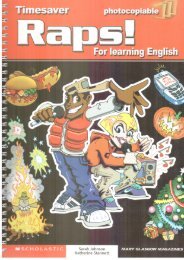English_Book_2-Teacher_300913
English_Book_2-Teacher_300913
English_Book_2-Teacher_300913
You also want an ePaper? Increase the reach of your titles
YUMPU automatically turns print PDFs into web optimized ePapers that Google loves.
TEACHER’S NOTES12 Practice (1 hour)A.• GROUPS. Read the instructions and havestudents fill in the name of their country. Elicit afew breakfast foods in <strong>English</strong>. Have students formgroups and write the breakfast foods they usuallyeat. (If your class is multinational, arrange studentsin groups according to country.) Have studentsuse a dictionary to find <strong>English</strong> equivalents orhelp students translate from L1 yourself. Check byeliciting the names of breakfast foods from the classand writing them on the board.B.• This activity requires students to have Internetaccess at school or at home. It can either be done inclass or assigned as homework.• Tell students to use the Internet to get informationabout the kinds of food people from othercountries have for breakfast. You may also wantto have students download and print picturesof these foods. Ask them to write down theURLs of the websites they got the information orpictures from. You may want to suggest websitesthat all students can use for their basic research;Wikipedia, for example, has a helpful entry onbreakfasts around the world.C.• Have students work in groups to share theirresearch and complete their charts.• To check, elicit the names of several breakfastfoods for each country. Elicit or explain what thefoods are, using L1 as needed.D.• GROUPS. Model asking and answering several ofthe questions in this exercise with a student. Thenhave students get together in groups to discuss.• When groups have finished, discuss thesequestions as a class.Focus on values• Explain to students that, in general, printingout information or pictures from the Internet isallowed for school or personal use. However,when they use a source for a class assignment,they should cite it. Explain that when we cite asource, we say where we got the information.We have to cite our sources when we takeand use information, ideas, or pictures fromsomeone’s website, book, speech, song, poem,play, or artwork. Citing sources is beingrespectful and honest.13 Reading (15 min.)Cross-curricular activity: math and social studies• If your students are unaccustomed to workingwith averages and bar graphs, ask a student howmany hours of sleep he or she got on differentweeknights—for example, How many hours didyou sleep on Monday night? On Tuesday night?Write these times on the board. Then average thetime. Show students how you total the hours anddivide the total hours by the number of days.Draw a vertical y axis on the board and labelit with Hours, and a horizontal x axis with thelabel Sleep (as in the Student <strong>Book</strong>). Complete thegraph by drawing a bar to indicate the averagenumber of hours of sleep. Ask How many hoursdoes this bar graph show?A.• Have students look at the graph. Tell students thatthis shows the average amount of time a studentspends doing things on weekdays. Give studentsa few moments to study the chart. Then ask Onthe graph, what does Other mean? (other activitiesthat a student does on a weekday) Ask studentsto give examples of activities that might be in thiscategory. (doing sports or hobbies, going out withfriends, listening to music)B.• Have students read the instructions aloud andcomplete the exercise individually. Check orally.Answer key1. 8 hours2. 7 hours3. 2 hours4. 4 hoursC.• Read the instructions aloud and have studentslook at the unfinished graph. Ask several studentsHow many hours a day do you sleep? Have studentscomplete this bar on the graph.• Have students work individually to completetheir graphs.14 Speaking (10 min.)• PAIRS. Read the instructions and examplesentences aloud. Then call on a pair to modelthe activity.• Have students form pairs and discuss their graphs.Check by calling on several pairs to tell you thesimilarities and differences in their daily routines.T19Postcards_splitB_TE1_U02.indd T192/27/07 10:22:10 AM014-023_




